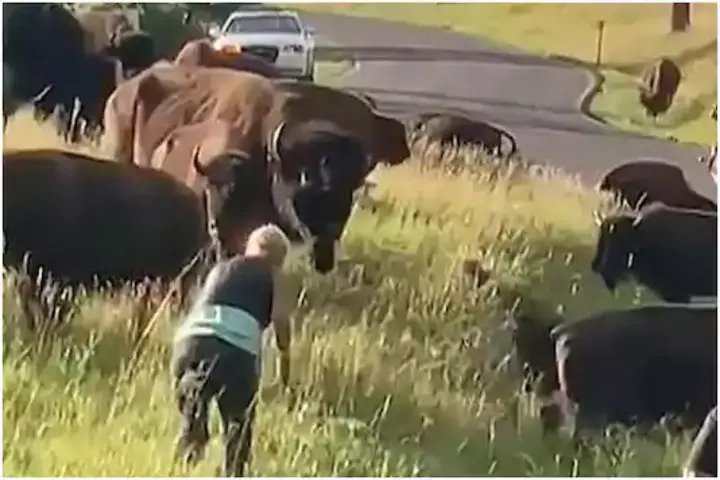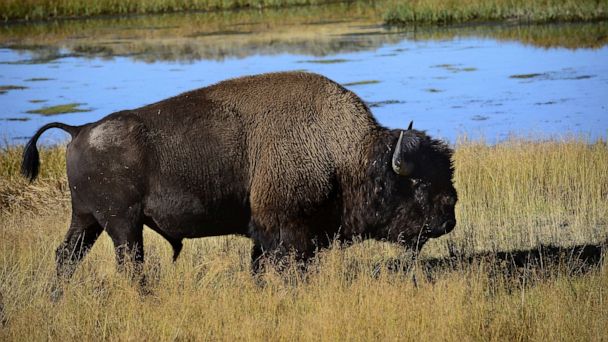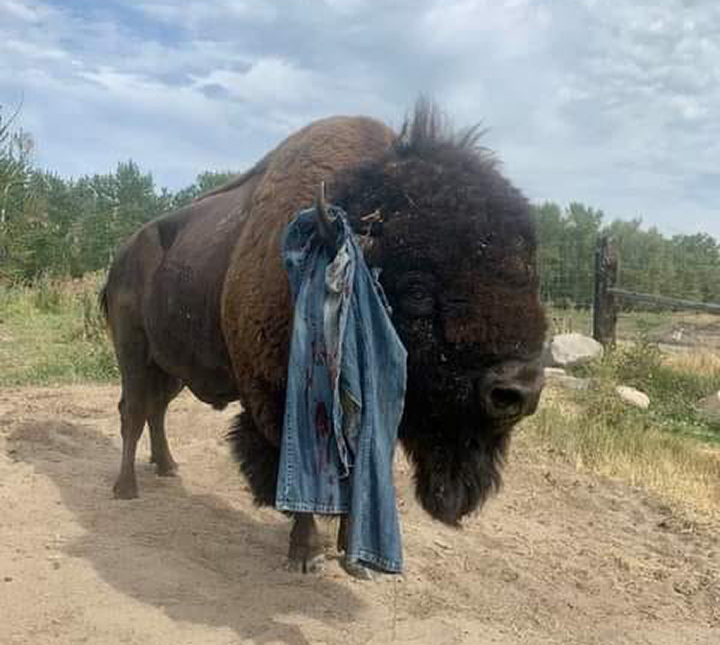Bison Attacks Woman and Rips off Her Pants
An Iowa woman who narrowly survived a bison attack serves as a stark reminder that mother nature deserves respect, and there are severe consequences for those who don’t follow some basic rules.
The woman, who has not been identified, was part of a motorcycle group making its way through South Dakota for the Sturgis Motorcycle Rally, happening about 60 miles from the Custer State Park, where the incident took place. The motorcycle caravan was traveling through the park when they were forced to a stop by a grazing herd of buffalo moving across the roadway.
As widely known by the viral video that has swept the internet, the woman approached the herd to get a photo of a calf standing near an adult buffalo. In the video, viewers can hear onlookers reacting in astonishment to the woman’s approach, telling her not to do it.
Warning language in the video
Within seconds, an adult bison charges the woman, hooking her through a belt loop on her jeans and swinging her around in circles like a rag doll. The woman was flung out of her jeans and onto the ground, unconscious but unhurt, according to a statement from Custer County Sheriff Marty Mechaley.
She was lucky, but it was dumb luck. She was ignoring (or ignorant of) basic guidelines for interacting with wildlife. Her attack happened one day after Yellowstone National Park released a video warning tourists not to engage with buffalo there. Based on the title of the video, it’s clear that tourists have a hard time keeping away from these 1,500+ pound behemoths that can crash into you like a car.
Each year in the United States, 47,000 people require medical attention due to a wild animal attack. Most of these are raccoon or snake bites, but according to a study by Utah State University, about 40 people every year will experience attacks from large animals like bears, bison, elk, and alligators.
The study noted that bison attacks are the most common type of animal-related injuries in Yellowstone National Park. Over the past four decades, 83 people have been injured or killed by bison in Yellowstone, with victims being an average of only 11 feet (3.5 meters) away from the bison when they were attacked, despite park regulations stating that people should not come within 75 feet (23 meters) of the animals.
As hunters and outdoors enthusiasts, it’s important we observe common-sense rules on how to safely observe – and appreciate – wild animals. It’s easy to think we are experts on treating nature with the respect it deserves, but it never hurts to get a refresher.
How to Avoid Getting Pantsed By a Bison
The National Parks Conservation Association has a great list for staying safe when you’re in the domain of wild animals. Their list, titled “10 Tips to Respect Wildlife, Stay Safe, and Avoid Internet Ridicule,” is a must-read for any would-be bison photographers, and is helpful for anyone who wants to properly respect the great outdoors. Here are a few of the tips they give:
- Don’t interfere with the course of nature. You might want to step in when you see a baby fawn (or bison calf) wandering alone, but if you try to touch it or help it, you could be doing more harm than good. You could bring out an angry mama whom you didn’t see grazing nearby, or you could cause the parent to reject its baby altogether. You can always call a Park Ranger or wildlife rescue organization to report what you’ve seen, but move along if you want to keep yourself, and the animals, safe.
- Invest in a zoom lens. You are in the animal’s territory, so you must act in a way that allows them to do their thing with the least amount of stress. It’s easy to misjudge the speed or power of a wild animal (American Bison can run up to 35 mph, which is eight mph faster than the fastest human alive, Usaine Bolt, who tops out at 27 mph). So, it is dangerous to get too close.
- Don’t touch the wildlife. This seems obvious, what with all of the advice to keep your distance that we’ve mentioned above. Even if you believe you’re helping an injured animal, the bottom line is, wildlife doesn’t like to be handled and they are likely to react in a way that can land you in the hospital or a starring role in a viral video.
The list offers more specific tips to park visitors who are likely to encounter bears, alligators, and certain species of sweat-craving danger goats, but the gist is the same: Keep your distance, respect the animals, and let nature run its course.
Do these three things, and you’ll avoid the totally-avoidable situation of becoming a YouTube sensation for all the wrong reasons.
Jeremy Mallette is co-founder of International Sportsman. An avid hunter and outdoorsman, he has spent more than a decade in the outdoor industry, from hiking and camping to silencers and hunting. His father taught him to shoot at age six, and he received his first firearm at age eight — a 1942 Colt Commando .38 special revolver. He enjoys yearly trips to Kansas for pheasant hunting, spending time with his children at the deer lease, and collecting unique firearms.



